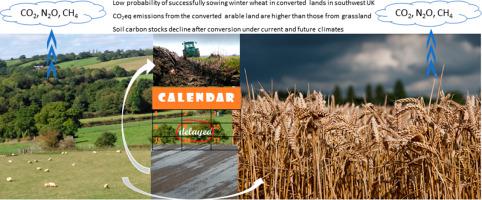Agricultural Systems ( IF 6.1 ) Pub Date : 2022-09-12 , DOI: 10.1016/j.agsy.2022.103500 Lianhai Wu , Lu Wu , Ian J. Bingham , Thomas H. Misselbrook

|
CONTEXT
Adapting to changes in climate and in consumer demand for commodities will force us to diversify land uses from the current status. Livestock grazing systems are dominant agricultural practices in the western regions of the British Isles. It has been suggested that grasslands in the region could be converted to other land uses, e.g. growing of cereal crops. We hypothesized that soil workability and trafficability would be important factors determining the feasibility and environmental impact of such conversion.
OBJECTIVE
Objectives were 1) to investigate the impacts of weather conditions under the current climate on agronomic management and crop yield of winter wheat using the SPACSYS model; and 2) to assess potential impacts of the land use conversion (grassland converted into arable land) on the environment under soil conditions representative of the region under baseline and future climatic conditions.
METHODS
Using simulation modelling we investigated the impacts of baseline and future climates under the Representative Concentration Pathways (RCP2.6, 4.5 and RCP8.5) on soil workability and trafficability at sowing and harvest respectively of winter wheat and its consequences for crop productivity and key indices of environmental sustainability for three major soil types of the region.
RESULTS AND CONCLUSIONS.
Under baseline and future projections, the probability of successfully sowing winter wheat on these soils was between 38 and 76%. Simulations showed that grassland conversion to arable in the region would not be sustainable in terms of carbon sequestration with a decline in soil carbon stock of 165–280 kg C ha−1 yr−1 on average over the simulation period. Rates of decline were greater when soil workability was taken into consideration. Although CO2eq emissions from silage–based grassland soil were higher than those from the converted arable land, these were offset by the greater net productivity of grassland making it a larger net sink for carbon. When soil workability at sowing was considered, the NUEcrop (crop N content/N fertiliser applied) for winter wheat was lower than that for perennial ryegrass on all soil types under the baseline climate and RCP2.6, but comparable or greater under RCP4.5 and RCP8.5. In terms of carbon sequestration, grassland conversion for production of winter wheat is unsustainable under these soil–climatic conditions.
SIGNIFICANCE
Our results demonstrated that soil workability is a major factor influencing the potential impact of land-use conversion in clay soils and a wetter climate.
中文翻译:

预计气候对土壤可耕性和可通行性的影响决定了将永久性草地转变为可耕地的可行性
语境
适应气候变化和消费者对商品的需求将迫使我们从目前的状态使土地利用多样化。牲畜放牧系统是不列颠群岛西部地区的主要农业实践。有人建议,该地区的草地可以转化为其他土地用途,例如种植谷类作物。我们假设土壤可加工性和可通行性将是决定这种转换的可行性和环境影响的重要因素。
客观的
目标是 1) 使用 SPACSYS 模型研究当前气候下天气条件对冬小麦农艺管理和作物产量的影响;2) 在基线和未来气候条件下,在代表该地区的土壤条件下,评估土地利用转变(草地转变为耕地)对环境的潜在影响。
方法
使用模拟模型,我们研究了代表性浓度路径(RCP2.6、4.5 和 RCP8.5)下基线和未来气候对冬小麦播种和收获时土壤的可加工性和可流通性的影响及其对作物生产力和关键指标的影响该地区三种主要土壤类型的环境可持续性。
结果和结论。
根据基线和未来预测,在这些土壤上成功播种冬小麦的概率在 38% 到 76% 之间。模拟表明,该地区的草地转化为可耕地在碳封存方面是不可持续的,在模拟期间土壤碳储量平均下降 165-280 kg C ha -1 yr -1。当考虑土壤可加工性时,下降率更大。尽管基于青贮饲料的草地土壤的 CO 2 eq 排放量高于转化耕地的排放量,但这些都被草地更高的净生产力所抵消,使其成为更大的碳净汇。当考虑播种时的土壤和易性时,NUE作物在基线气候和 RCP2.6 下,所有土壤类型的冬小麦(作物氮含量/施氮肥)低于多年生黑麦草,但在 RCP4.5 和 RCP8.5 下相当或更高。在碳固存方面,在这些土壤气候条件下,用于生产冬小麦的草地转化是不可持续的。
意义
我们的研究结果表明,土壤和易性是影响粘土和潮湿气候中土地利用转换潜在影响的主要因素。











































 京公网安备 11010802027423号
京公网安备 11010802027423号